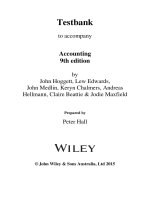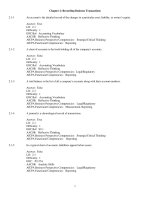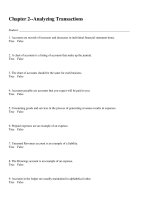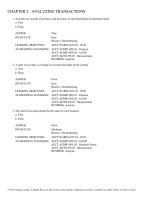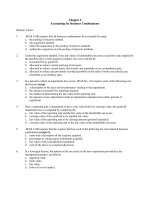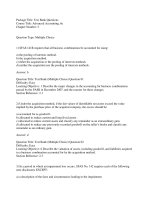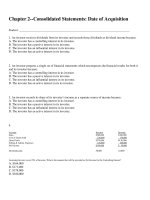advanced accounting 13th edition hoyle test bank
Bạn đang xem bản rút gọn của tài liệu. Xem và tải ngay bản đầy đủ của tài liệu tại đây (791.42 KB, 65 trang )
Advanced Accounting 13th Edition Hoyle Test Bank
Full clear download (no famatting errors) at:
File: Chapter 02 - Consolidation of Financial Information
Multiple Choice:
[QUESTION]
1. At the date of an acquisition which is not a bargain purchase, the acquisition method
A) Consolidates the subsidiary’s assets at fair value and the liabilities at book value.
B) Consolidates all subsidiary assets and liabilities at book value.
C) Consolidates all subsidiary assets and liabilities at fair value.
D) Consolidates current assets and liabilities at book value, and long-term assets and liabilities at
fair value.
E) Consolidates the subsidiary’s assets at book value and the liabilities at fair value.
Answer: C
Learning Objective: 02-04
Learning Objective: 02-05
Topic: Acquisition―Valuation principles
Topic: Acquisition―Allocate fair value
Difficulty: 1 Easy
Blooms: Remember
AACSB: Reflective Thinking
AICPA: BB Critical Thinking
AICPA: FN Measurement
[QUESTION]
2. In an acquisition where 100% control is acquired, how would the land accounts of the parent
and the land accounts of the subsidiary be reported on consolidated financial statements?
A)
B)
C)
D)
E)
Parent
Book Value
Book Value
Fair Value
Fair Value
Cost
Answer: B
Learning Objective: 02-04
Subsidiary
Book Value
Fair Value
Fair Value
Book Value
Cost
Learning Objective: 02-05
Topic: Acquisition―Valuation principles
Topic: Acquisition―Allocate fair value
Difficulty: 2 Medium
Blooms: Remember
AACSB: Reflective Thinking
AICPA: BB Critical Thinking
AICPA: FN Measurement
[QUESTION]
3. Lisa Co. paid cash for all of the voting common stock of Victoria Corp. Victoria will continue
to exist as a separate corporation. Entries for the consolidation of Lisa and Victoria would be
recorded in
A) A worksheet.
B) Lisa's general journal.
C) Victoria's general journal.
D) Victoria's secret consolidation journal.
E) The general journals of both companies.
Answer: A
Learning Objective: 02-07
Topic: Consolidation worksheet
Difficulty: 1 Easy
Blooms: Remember
AACSB: Reflective Thinking
AICPA: BB Critical Thinking
AICPA: FN Measurement
[QUESTION]
4. Using the acquisition method for a business combination, goodwill is generally calculated as
the:
A) Cost of the investment less the subsidiary's book value at the beginning of the year.
B) Cost of the investment less the subsidiary's book value at the acquisition date.
C) Cost of the investment less the subsidiary's fair value at the beginning of the year.
D) Cost of the investment less the subsidiary's fair value at acquisition date.
E) Zero, it is no longer allowed under federal law.
Answer: D
Learning Objective: 02-04
Learning Objective: 02-05
Topic: Acquisition―Valuation principles
Topic: Acquisition―Calculate goodwill or bargain
Difficulty: 2 Medium
Blooms: Remember
AACSB: Reflective Thinking
AICPA: BB Critical Thinking
AICPA: FN Measurement
[QUESTION]
5. Direct combination costs and amounts incurred to register and issue stock in connection with a
business combination. How should those costs be accounted for in a pre-2009 business
combination?
Direct Combination Costs
Stock Issuance Costs
A) Increase Investment
Decrease Investment
B)
Increase Investment
Decrease Additional Paid-in Capital
C)
Increase Investment
Increase Expenses
D) Decrease Additional Paid-in Capital Increase Investment
E)
Increase Expenses
Decrease Investment
Answer: B
Learning Objective: 02-09
Topic: Legacy methods―Purchase and pooling
Difficulty: 2 Medium
Blooms: Remember
AACSB: Reflective Thinking
AICPA: BB Critical Thinking
AICPA: FN Measurement
[QUESTION]
6. How are direct and indirect costs accounted for when applying the acquisition method for a
business combination?
Answer: A
Learning Objective: 02-06b
Topic: Costs of combination
Difficulty: 1 Easy
Blooms: Remember
AACSB: Reflective Thinking
AICPA: BB Critical Thinking
AICPA: FN Measurement
[QUESTION]
7. What is the primary difference between: (i) accounting for a business combination when the
subsidiary is dissolved; and (ii) accounting for a business combination when the subsidiary
retains its incorporation?
A) If the subsidiary is dissolved, it will not be operated as a separate division.
B) If the subsidiary is dissolved, assets and liabilities are consolidated at their book values.
C) If the subsidiary retains its incorporation, there will be no goodwill associated with the
acquisition.
D) If the subsidiary retains its incorporation, assets and liabilities are consolidated at their book
values.
E) If the subsidiary retains its incorporation, the consolidation is not formally recorded in the
accounting records of the acquiring company.
Answer: E
Learning Objective: 02-03
Learning Objective: 02-06a
Learning Objective: 02-06c
Topic: Business combination―Differentiate across forms
Topic: Journal entry―Dissolution
Topic: Journal entry―Investment with no dissolution
Difficulty: 2 Medium
Blooms: Understand
AACSB: Reflective Thinking
AICPA: BB Critical Thinking
AICPA: FN Measurement
[QUESTION]
8. According to GAAP, which of the following is true with respect to the pooling of interest
method of accounting for business combinations?
A) It was the only method used prior to 2002.
B) It must be used for all new acquisitions.
C) GAAP allowed its use prior to 2002.
D) It, or the acquisition method, may be used at the acquirer’s discretion.
E) GAAP requires it to be used instead of the acquisition method for business combinations for
which $50 billion or more in consideration is transferred.
Answer: C
Learning Objective: 02-09
Topic: Legacy methods―Purchase and pooling
Difficulty: 1 Easy
Blooms: Remember
AACSB: Reflective Thinking
AICPA: BB Critical Thinking
AICPA: FN Measurement
[QUESTION]
9. Which of the following examples accurately describes a difference in the types of business
combinations?
A) A statutory merger can only be effected through an asset acquisition while a statutory
consolidation can only be effected through a capital stock acquisition.
B) A statutory merger can only be effected through a capital stock acquisition while a statutory
consolidation can only be effected through an asset acquisition.
C) A statutory merger requires the dissolution of the acquired company while a statutory
consolidation requires dissolution of the companies involved in the combination following the
transfer of assets or stock to a newly formed entity.
D) A statutory consolidation requires dissolution of the acquired company while a statutory
merger does not require dissolution.
E) Both a statutory merger and a statutory consolidation can only be effected through an asset
acquisition but only a statutory consolidation requires dissolution of the acquired company.
Answer: C
Learning Objective: 02-03
Topic: Business combination―Differentiate across forms
Difficulty: 3 Hard
Blooms: Remember
AACSB: Reflective Thinking
AICPA: BB Critical Thinking
AICPA: FN Measurement
[QUESTION]
10. Acquired in-process research and development is considered as
A) A definite-lived asset subject to amortization.
B) A definite-lived asset subject to testing for impairment.
C) An indefinite-lived asset subject to amortization.
D) An indefinite-lived asset subject to testing for impairment.
E) A research and development expense at the date of acquisition.
Answer: D
Learning Objective: 02-08
Topic: In-process research and development
Difficulty: 1 Easy
Blooms: Remember
AACSB: Reflective Thinking
AICPA: BB Critical Thinking
AICPA: FN Measurement
[QUESTION]
11. Which of the following statements is true regarding the acquisition method of accounting for
a business combination?
A) The combination must involve the exchange of equity securities only.
B) The transaction establishes an acquisition fair value basis for the company being acquired.
C) The two companies may be about the same size, and it is difficult to determine the acquired
company and the acquiring company.
D) The transaction may be considered to be the uniting of the ownership interests of the
companies involved.
E) The acquired subsidiary must be smaller in size than the acquiring parent.
Answer: B
Learning Objective: 02-04
Topic: Acquisition―Valuation principles
Difficulty: 1 Easy
Blooms: Remember
AACSB: Reflective Thinking
AICPA: BB Critical Thinking
AICPA: FN Measurement
[QUESTION]
12. With respect to recognizing and measuring the fair value of a business combination in
accordance with the acquisition method of accounting, which of the following should the acquirer
consider when determining fair value?
A) Only assets received by the acquirer.
B) Only consideration transferred by the acquirer.
C) The consideration transferred by the acquirer plus the fair value of assets received less
liabilities assumed.
D) The par value of stock transferred by the acquirer, and the book value of identifiable assets
transferred by the entity acquired.
E) The book value of identifiable assets transferred to the acquirer as part of the business
combination less any liabilities assumed.
Answer: C
Learning Objective: 02-04
Topic: Acquisition―Valuation principles
Difficulty: 3 Hard
Blooms: Understand
AACSB: Reflective Thinking
AICPA: BB Critical Thinking
AICPA: FN Measurement
[QUESTION]
13. A statutory merger is a(n)
A) Business combination in which only one of the two companies continues to exist as a legal
corporation.
B) Business combination in which both companies continue to exist.
C) Acquisition of a competitor.
D) Acquisition of a supplier or a customer.
E) Legal proposal to acquire outstanding shares of the target's stock.
Answer: A
Learning Objective: 02-03
Topic: Business combination―Differentiate across forms
Difficulty: 2 Medium
Blooms: Remember
AACSB: Reflective Thinking
AICPA: BB Critical Thinking
AICPA: FN Measurement
[QUESTION]
14. In a business combination where a subsidiary retains its incorporation and which is accounted
for under the acquisition method, how should stock issuance costs and direct combination costs
be treated?
A) Stock issuance costs and direct combination costs are expensed as incurred.
B) Direct combination costs are ignored, and the stock issuance costs result in a reduction to
additional paid-in capital.
C) Direct combination costs are expensed as incurred and stock issuance costs result in a
reduction to additional paid-in capital.
D) Both are treated as part of the acquisition consideration transferred.
E) Both reduce additional paid-in capital.
Answer: C
Learning Objective: 02-06b
Topic: Costs of combination
Difficulty: 2 Medium
Blooms: Remember
AACSB: Reflective Thinking
AICPA: BB Critical Thinking
AICPA: FN Measurement
REFERENCE: 02-01
Bullen Inc. acquired 100% of the voting common stock of Vicker Inc. on January 1, 2018. The
book value and fair value of Vicker's accounts on that date (prior to creating the combination) are
as follows, along with the book value of Bullen's accounts:
Retained earnings, 1/1/20
Cash and receivables
Inventory
Land
Buildings (net)
Equipment (net)
Liabilities
Common stock
Additional paid-in capital
Bullen
Book
Value
$250,000
170,000
230,000
280,000
480,000
120,000
650,000
360,000
20,000
Vicker
Book
Value
$240,000
70,000
170,000
220,000
240,000
90,000
430,000
80,000
40,000
Vicker
Fair
Value
$70,000
210,000
240,000
270,000
90,000
420,000
15. Assume that Bullen issued 12,000 shares of common stock, with a $5 par value and a $47 fair
value, to obtain all of Vicker's outstanding stock. In this acquisition transaction, how much
goodwill should be recognized?
A) $144,000.
B) $104,000.
C) $ 64,000.
D) $ 60,000.
E) $
0.
Answer: B
Learning Objective: 02-05
Topic: Acquisition―Calculate consideration transferred
Topic: Acquisition―Calculate goodwill or bargain
Difficulty: 2 Medium
Blooms: Apply
AACSB: Knowledge Application
AICPA: BB Critical Thinking
AICPA: FN Measurement
Feedback: Goodwill = Consideration Transferred less Acquisition Date Fair Value of Net Assets
Acquired and Liabilities Assumed
Consideration Transferred: $47 × 12,000 = $564,000
Fair Value of Assets Acquired: 70,000 (cash and receivables) + 210,000 (inventory) + 240,000
(land) + 270,000 (buildings) + 90,000 (equipment) = $880,000
Fair Value of Liabilities Assumed: $420,000
Consideration Less Net Assets/Liabilities = $880,000 - $420,000 = $460,000
Goodwill: $564,000 - $460,000 = $104,000
[QUESTION]
REFER TO: 02-01
16. Assume that Bullen issued 12,000 shares of common stock with a $5 par value and a $47 fair
value for all of the outstanding stock of Vicker. What is the consolidated balance for Land as a
result of this acquisition transaction?
A) $460,000.
B) $510,000.
C) $500,000.
D) $520,000.
E) $490,000.
Answer: D
Learning Objective: 02-05
Learning Objective: 02-06a
Learning Objective: 02-07
Topic: Acquisition―Allocate fair value
Topic: Acquisition―Calculate consolidated balances
Difficulty: 2 Medium
Blooms: Apply
AACSB: Knowledge Application
AICPA: BB Critical Thinking
AICPA: FN Measurement
Feedback: $280,000 (Bullen Land) + $240,000 (Vicker Land) = $520,000
17. Assume that Bullen issued 12,000 shares of common stock with a $5 par value and a $47 fair
value for all of the outstanding shares of Vicker. What will be the consolidated Additional PaidIn Capital and Retained Earnings (January 1, 2018 balances) as a result of this acquisition
transaction?
A) $60,000 and $490,000.
B) $60,000 and $250,000.
C) $380,000 and $250,000.
D) $524,000 and $250,000.
E) $524,000 and $420,000.
Answer: D
Learning Objective: 02-05
Learning Objective: 02-06a
Learning Objective: 02-07
Topic: Acquisition―Calculate consideration transferred
Topic: Acquisition―Calculate consolidated balances
Difficulty: 3 Hard
Blooms: Apply
AACSB: Knowledge Application
AICPA: BB Critical Thinking
AICPA: FN Measurement
Feedback: Consolidated Additional Paid-In Capital = Bullen APIC ($20,000) + APIC related to
stock issued in connection with Vicker business combination ($42 × 12,000) = $20,000 +
$504,000 = $524,000
Bullen’s Retained Earnings: $250,000
[QUESTION]
REFER TO: 02-01
18. Assume that Bullen issued preferred stock with a par value of $240,000 and a fair value of
$500,000 for all of the outstanding shares of Vicker in an acquisition business combination. What
will be the balance in the consolidated Inventory and Land accounts?
A) $440,000, $496,000.
B) $440,000, $520,000.
C) $425,000, $505,000.
D) $400,000, $500,000.
E) $427,000, $510,000.
Answer: B
Learning Objective: 02-05
Learning Objective: 02-06a
Learning Objective: 02-07
Topic: Acquisition―Allocate fair value
Topic: Acquisition―Calculate consolidated balances
Difficulty: 2 Medium
Blooms: Apply
AACSB: Knowledge Application
AICPA: BB Critical Thinking
AICPA: FN Measurement
Feedback: Inventory $230,000 BV + $210,000 FV = $440,000
Land $280,000 BV + $240,000 FV = $520,000
19. Assume that Bullen paid a total of $480,000 in cash for all of the shares of Vicker. In
addition, Bullen paid $35,000 for secretarial and management time allocated to the acquisition
transaction. What will be the balance in consolidated goodwill?
A) $
0.
B) $20,000.
C) $35,000.
D) $55,000.
E) $65,000.
Answer: B
Learning Objective: 02-05
Learning Objective: 02-06b
Topic: Acquisition―Calculate goodwill or bargain
Topic: Costs of combination
Difficulty: 2 Medium
Blooms: Apply
AACSB: Knowledge Application
AICPA: BB Critical Thinking
AICPA: FN Measurement
Feedback: Fair value of consideration transferred less fair value of net assets = goodwill
$480,000 – (70,000+210,000+240,000+270,000+90,000-420,000) = $20,000 Excess
REFERENCE: 02-02
Prior to being united in a business combination, Botkins Inc. and Volkerson Corp. had the
following stockholders' equity figures:
Common stock ($1 par value)
Additional paid-in capital
Retained earnings
Botkins
$ 220,000
110,000
360,000
Volkerson
$ 54,000
25,000
130,000
Botkins issued 56,000 new shares of its common stock valued at $3.25 per share for all of the
outstanding stock of Volkerson.
[QUESTION]
REFER TO: 02-02
20. Assume that Botkins acquired Volkerson on January 1, 2017 and that Volkerson maintains a
separate corporate existence. At what amount did Botkins record the investment in Volkerson?
A) $ 56,000.
B) $182,000.
C) $209,000.
D) $261,000.
E) $312,000.
Answer: B
Learning Objective: 02-06c
Topic: Journal entry―Investment with no dissolution
Difficulty: 1 Easy
Blooms: Apply
AACSB: Knowledge Application
AICPA: BB Critical Thinking
AICPA: FN Measurement
[QUESTION]
REFER TO: 02-02
21. Assume that Botkins acquired Volkerson on January 1, 2017. Immediately afterwards, what
is the value of the consolidated Common Stock?
A) $456,000.
B) $402,000.
C) $274,000.
D) $276,000.
E) $330,000.
Answer: D
Learning Objective: 02-05
Learning Objective: 02-06a
Learning Objective: 02-07
Topic: Acquisition―Calculate consideration transferred
Topic: Acquisition―Calculate consolidated balances
Difficulty: 2 Medium
Blooms: Apply
AACSB: Knowledge Application
AICPA: BB Critical Thinking
AICPA: FN Measurement
Feedback: $220,000 + ($1.00 × 56,000) = $276,000
[QUESTION]
22. Chapel Hill Company had common stock of $350,000 and retained earnings of $490,000.
Blue Town Inc. had common stock of $700,000 and retained earnings of $980,000. On January
1, 2018, Blue Town issued 34,000 shares of common stock with a $12 par value and a $35 fair
value for all of Chapel Hill Company's outstanding common stock. This combination was
accounted for using the acquisition method. Immediately after the combination, what was the
amount of total consolidated net assets?
A) $2,520,000.
B) $1,190,000.
C) $1,680,000.
D) $2,870,000.
E) $2,030,000.
Answer: D
Learning Objective: 02-05
Learning Objective: 02-06a
Learning Objective: 02-07
Topic: Acquisition―Calculate goodwill or bargain
Topic: Acquisition―Calculate consolidated balances
Difficulty: 2 Medium
Blooms: Apply
AACSB: Knowledge Application
AICPA: BB Critical Thinking
AICPA: FN Measurement
Feedback: Consideration Transferred = Net Fair Value of Assets Acquired and Liabilities
Assumed
Consideration Transferred: $35 per share × 34,000 shares = $1,190,000
Net Fair Value of Assets/Liabilities: $700,000 + $980,000 = $1,680,000
Total: $1,190,000 + $1,680,000 = $2,870,000
[QUESTION]
23. Which of the following is a not a reason for a business combination to take place?
A) Cost savings through elimination of duplicate facilities.
B) Quick entry for new and existing products into domestic and foreign markets.
C) Diversification of business risk.
D) Vertical integration.
E) Increase in stock price of the acquired company.
Answer: E
Learning Objective: 02-01
Topic: Business combination―Reasons to combine
Difficulty: 1 Easy
Blooms: Remember
AACSB: Reflective Thinking
AICPA: BB Critical Thinking
AICPA: FN Measurement
[QUESTION]
24. Which of the following statements is true regarding a statutory merger?
A) The original companies dissolve while remaining as separate divisions of a newly created
company.
B) Both companies remain in existence as legal corporations with one corporation now a
subsidiary of the acquiring company.
C) The acquired company dissolves as a separate corporation and becomes a division of the
acquiring company.
D) The acquiring company acquires the stock of the acquired company as an investment.
E) A statutory merger is no longer a legal option.
Answer: C
Learning Objective: 02-03
Topic: Business combination―Differentiate across forms
Difficulty: 2 Medium
Blooms: Remember
AACSB: Reflective Thinking
AICPA: BB Critical Thinking
AICPA: FN Measurement
[QUESTION]
25. Which of the following statements is true regarding a statutory consolidation?
A) The original companies dissolve while remaining as separate divisions of a newly created
company.
B) Both companies remain in existence as legal corporations with one corporation now a
subsidiary of the acquiring company.
C) The acquired company dissolves as a separate corporation and becomes a division of the
acquiring company.
D) The acquiring company acquires the stock of the acquired company as an investment.
E) A statutory consolidation is no longer a legal option.
Answer: A
Learning Objective: 02-03
Topic: Business combination―Differentiate across forms
Difficulty: 2 Medium
Blooms: Remember
AACSB: Reflective Thinking
AICPA: BB Critical Thinking
AICPA: FN Measurement
[QUESTION]
26. In a transaction accounted for using the acquisition method where consideration transferred
exceeds book value of the acquired company, which statement is true for the acquiring company
with regard to its investment?
A) Net assets of the acquired company are revalued to their fair values and any excess of
consideration transferred over fair value of net assets acquired is allocated to goodwill.
B) Net assets of the acquired company are maintained at book value and any excess of
consideration transferred over book value of net assets acquired is allocated to goodwill.
C) Acquired assets are revalued to their fair values. Acquired liabilities are maintained at book
values. Any excess is allocated to goodwill.
D) Acquired long-term assets are revalued to their fair values. Any excess is allocated to
goodwill.
Answer: A
Learning Objective: 02-04
Learning Objective: 02-05
Topic: Acquisition―Valuation principles
Topic: Acquisition―Allocate fair value
Difficulty: 2 Medium
Blooms: Analyze
AACSB: Analytical Thinking
AICPA: BB Critical Thinking
AICPA: FN Measurement
[QUESTION]
27. In a transaction accounted for using the acquisition method where consideration transferred is
less than fair value of net assets acquired, which statement is true?
A) Negative goodwill is recorded.
B) A deferred credit is recorded.
C) A gain on bargain purchase is recorded.
D) Long-term assets of the acquired company are reduced in proportion to their fair values. Any
excess is recorded as a deferred credit.
E) Long-term assets and liabilities of the acquired company are reduced in proportion to their fair
values. Any excess is recorded as gain.
Answer: C
Learning Objective: 02-04
Learning Objective: 02-05
Topic: Acquisition―Valuation principles
Topic: Acquisition―Calculate goodwill or bargain
Difficulty: 1 Easy
Blooms: Analyze
AACSB: Analytical Thinking
AICPA: BB Critical Thinking
AICPA: FN Measurement
[QUESTION]
28. Which of the following statements is true regarding the acquisition method of accounting for
a business combination?
A) Net assets of the acquired company are reported at their fair values.
B) Net assets of the acquired company are reported at their book values.
C) Any goodwill associated with the acquisition is reported as a development cost.
D) The acquisition can only be effected by a mutual exchange of voting common stock.
E) Indirect costs of the combination reduce additional paid-in capital.
Answer: A
Learning Objective: 02-04
Topic: Acquisition―Valuation principles
Difficulty: 2 Medium
Blooms: Remember
AACSB: Reflective Thinking
AICPA: BB Critical Thinking
AICPA: FN Measurement
[QUESTION]
29. Which of the following statements is true?
A) The pooling of interests for business combinations is an alternative to the acquisition method.
B) The purchase method for business combinations is an alternative to the acquisition method.
C) Neither the purchase method nor the pooling of interests method is allowed for new business
combinations.
D) Any previous business combination originally accounted for under purchase or pooling of
interests accounting method will now be accounted for under the acquisition method of
accounting for business combinations.
E) Companies previously using the purchase or pooling of interests accounting method must
report a change in accounting principle when consolidating those subsidiaries with new
acquisition combinations.
Answer: C
Learning Objective: 02-09
Topic: Legacy methods―Purchase and pooling
Difficulty: 2 Medium
Blooms: Remember
AACSB: Reflective Thinking
AICPA: BB Critical Thinking
AICPA: FN Measurement
REFERENCE: 02-03
The financial statements for Goodwin, Inc., and Corr Company for the year ended December 31,
2018, prior to the business combination whereby Goodwin acquired Corr, are as follows (in
thousands):
Goodwin
$2,700
1,980
$ 720
Corr
$600
400
$200
Retained earnings 1/1
Net income
Dividends
Retained earnings, 12/31
$2,400
720
(270)
$2,850
$400
200
(0)
$600
Cash
Receivables and inventory
Buildings (net)
Equipment (net)
Total assets
$ 240
1,200
2,700
2,100
$6,240
$ 220
340
600
1,200
$2,360
Liabilities
Common stock
Additional paid-in capital
Retained earnings
Total liabilities & stockholders’ equity
$1,500
1,080
810
2,850
$6,240
$ 820
400
540
600
$2,360
Revenues
Expenses
Net income
On December 31, 2018, Goodwin obtained a loan for $600 and used the proceeds, along with the
transfer of 30 shares of its $10 par value common stock, in exchange for all of Corr’s common
stock. At the time of the transaction, Goodwin’s common stock had a fair value of $40 per share.
In connection with the business combination, Goodwin paid $25 to a broker for arranging the
transaction and $35 in stock issuance costs. At the time of the transaction, Corr's equipment was
actually worth $1,400 but its buildings were only valued at $560.
[QUESTION]
REFER TO: 02-03
30. Assuming that Corr retains a separate corporate existence after this acquisition, at what
amount is the investment recorded on Goodwin's books?
A) $1,540.
B) $1,800.
C) $1,860.
D) $1,825.
E) $1,625.
Answer: B
Learning Objective: 02-06b
Learning Objective: 02-06c
Topic: Costs of combination
Topic: Journal entry―Investment with no dissolution
Difficulty: 2 Medium
Blooms: Apply
AACSB: Knowledge Application
AICPA: BB Critical Thinking
AICPA: FN Measurement
Feedback: $600 Cash + ($40 per share × 30 shares) = $1,800 Investment
[QUESTION]
REFER TO: 02-03
31. In this acquisition business combination, what total amount of common stock and additional
paid-in capital should Goodwin recognize on its consolidated financial statements?
A) $ 265.
B) $1,165.
C) $1,200.
D) $1,235.
E) $1,765.
Answer: B
Learning Objective: 02-05
Learning Objective: 02-06a
Learning Objective: 02-06b
Learning Objective: 02-07
Topic: Acquisition―Calculate consideration transferred
Topic: Costs of combination
Topic: Acquisition―Calculate consolidated balances
Difficulty: 2 Medium
Blooms: Apply
AACSB: Knowledge Application
AICPA: BB Critical Thinking
AICPA: FN Measurement
Feedback: Total for Common Stock equals par value of stock; with respect to stock issued, APIC
is adjusted by the amount fair value exceeds par value + stock issuance costs.
Common Stock: $10 par value per share x 30 shares = $300
APIC: Excess Value of Stock Over Par = $30 x 30 shares = $900
APIC: Stock Issuance Costs = $35
Total APIC = $300 + $900 - $35 = $1,165
[QUESTION]
REFER TO: 02-03
32. Compute the consolidated revenues for 2018.
A) $2,700.
B) $ 720.
C) $ 920.
D) $3,300.
E) $1,540.
Answer: A
Learning Objective: 02-06a
Learning Objective: 02-07
Topic: Acquisition―Calculate consolidated balances
Difficulty: 1 Easy
Blooms: Apply
AACSB: Knowledge Application
AICPA: BB Critical Thinking
AICPA: FN Measurement
Feedback: $2,700 Parent’s Revenue Only
[QUESTION]
REFER TO: 02-03
33. Compute the consolidated receivables and inventory for 2018.
A) $1,200.
B) $1,515.
C) $1,540.
D) $1,800.
E) $2,140.
Answer: C
Learning Objective: 02-05
Learning Objective: 02-06a
Learning Objective: 02-07
Topic: Acquisition―Allocate fair value
Topic: Acquisition―Calculate consolidated balances
Difficulty: 1 Easy
Blooms: Apply
AACSB: Knowledge Application
AICPA: BB Critical Thinking
AICPA: FN Measurement
Feedback: $1,200 + $340 = $1,540
[QUESTION]
REFER TO: 02-03
34. Compute the consolidated expenses for 2018.
A) $1,980.
B) $2,005.
C) $2,040.
D) $2,380.
E) $2,405.
Answer: B
Learning Objective: 02-06a
Learning Objective: 02-06b
Learning Objective: 02-07
Topic: Costs of combination
Topic: Acquisition―Calculate consolidated balances
Difficulty: 2 Medium
Blooms: Apply
AACSB: Knowledge Application
AICPA: BB Critical Thinking
AICPA: FN Measurement
Feedback: Consolidated Expenses = Goodwin’s Expenses + Corr’s Expenses immediately
following the transaction
Goodwin’s Expenses = $1,980 (2018 Expenses Reported on Financial Statements) + $25 (Fees
Expensed as Incurred) = $2,005
[QUESTION]
REFER TO: 02-03
35. Compute the consolidated cash account at December 31, 2018.
A) $460.
B) $425.
C) $400.
D) $435.
E) $240.
Answer: C
Learning Objective: 02-05
Learning Objective: 02-06a
Learning Objective: 02-06b
Learning Objective: 02-07
Topic: Acquisition―Calculate consideration transferred
Topic: Costs of combination
Topic: Acquisition―Calculate consolidated balances
Difficulty: 2 Medium
Blooms: Apply
AACSB: Knowledge Application
AICPA: BB Critical Thinking
AICPA: FN Measurement
Feedback: Consolidated Cash Equals Goodwin’s Cash + Corr’s Cash – Cash to Pay Costs and
Expenses Related to Business Combination
Goodwin’s Cash: $240
Corr’s Cash: $220
Costs and Expenses: $25 + $35 = $60
Consolidated Total = $240 + $220 = $460 – ($25 + $35) = $400
[QUESTION]
REFER TO: 02-03
36. Compute the consolidated buildings (net) account at December 31, 2018.
A) $2,700.
B) $3,370.
C) $3,300.
D) $3,260.
E) $3,340.
Answer: D
Learning Objective: 02-05
Learning Objective: 02-06a
Learning Objective: 02-07
Topic: Acquisition―Allocate fair value
Topic: Acquisition―Calculate consolidated balances
Difficulty: 2 Medium
Blooms: Apply
AACSB: Knowledge Application
AICPA: BB Critical Thinking
AICPA: FN Measurement
Feedback: Consolidated Value of Buildings Determined by adding the book value of Goodwin’s
buildings ($2,700) to the Fair Value of Corr’s buildings ($560 FV) = $3,260
[QUESTION]
REFER TO: 02-03
37. Compute the consolidated equipment (net) account at December 31, 2018.
A) $2,100.
B) $3,500.
C) $3,300.
D) $3,000.
E) $3,200.
Answer: B
Learning Objective: 02-05
Learning Objective: 02-06a
Learning Objective: 02-07
Topic: Acquisition method―Allocate fair value
Topic: Acquisition―Calculate consolidated balances
Difficulty: 2 Medium
Blooms: Apply
AACSB: Knowledge Application
AICPA: BB Critical Thinking
AICPA: FN Measurement
Feedback: Consolidated Value of Equipment (net) Determined by adding the book value of
Goodwin’s Equipment Account ($2,100) to the Fair Value of Corr’s Equipment (net) ($1,400) for
a total consolidated fair value of $3,500
[QUESTION]
REFER TO: 02-03
38. Compute the consideration transferred for this acquisition at December 31, 2018.
A) $ 900.
B) $1,165.
C) $1,200.
D) $1,765.
E) $1,800.
Answer: E
Learning Objective: 02-05
Topic: Acquisition―Calculate consideration transferred
Difficulty: 2 Medium
Blooms: Apply
AACSB: Knowledge Application
AICPA: BB Critical Thinking
AICPA: FN Measurement
Feedback: Consideration transferred equals fair value of cash ($600) + fair value of Goodwin
stock issued ($40 per share × 30 shares) = $600 + $1,200 = $1,800
[QUESTION]
REFER TO: 02-03
39. Compute the goodwill arising from this acquisition at December 31, 2018.
A) $ 0.
B) $100.
C) $125.
D) $160.
E) $ 45.
Answer: B
Learning Objective: 02-05
Topic: Acquisition―Calculate goodwill or bargain
Difficulty: 2 Medium
Blooms: Apply
AACSB: Knowledge Application
AICPA: BB Critical Thinking
AICPA: FN Measurement
Feedback: Goodwill equals excess of: (i) fair value of assets received and liabilities assumed; less
(ii) consideration paid.
Fair value of assets received: $220 cash + $340 receivables and inventory + $560 fair value of
buildings (net) + $1,400 fair value of equipment (net) = $2,520
Fair value of liabilities assumed: $820
Consideration paid: $600 cash + FV of common stock ($40 × 30 = $1,200) = $1,800
Goodwill = Consideration Paid ($1,800) less Fair Value of assets received and liabilities assumed
($2,520 assets received - $820 liabilities assumed = $1,700) = $1,800 - $1,700 = $100
[QUESTION]
REFER TO: 02-03
40. Compute the consolidated common stock account at December 31, 2018.
A) $1,080.
B) $1,480.
C) $1,380.
D) $2,280.
E) $2,680.
Answer: C
Learning Objective: 02-05
Learning Objective: 02-06a
Learning Objective: 02-07
Topic: Acquisition―Calculate consideration transferred
Topic: Acquisition―Calculate consolidated balances
Difficulty: 2 Medium
Blooms: Apply
AACSB: Knowledge Application
AICPA: BB Critical Thinking
AICPA: FN Measurement
Feedback: Goodwin Stock (par value $1,080) + Stock Issued for Corr (par value $10 × 30 shares)
= $1,080 + $300 = $1,380
[QUESTION]
REFER TO: 02-03
41. Compute the consolidated additional paid-in capital at December 31, 2018.
A) $ 810.
B) $1,350.
C) $1,675.
D) $1,910.
E) $1,875.
Answer: C
Learning Objective: 02-05
Learning Objective: 02-06a
Learning Objective: 02-06b
Learning Objective: 02-07
Topic: Acquisition―Calculate consideration transferred
Topic: Costs of combination
Topic: Acquisition―Calculate consolidated balances
Difficulty: 3 Hard
Blooms: Apply
AACSB: Knowledge Application
AICPA: BB Critical Thinking
AICPA: FN Measurement
Feedback: Goodwin’s APIC total ($810) + Corr’s APIC total
Corr’s APIC total: Excess of FV of shares issued on combination to Corr over par value, ($40 $10) × 30 shares = $30 × 30 shares = $900) less Stock Issuance Costs ($35) = $900 - $35 = $865
Consolidated APIC = $810 (Goodwin) + $865 (Corr) = $1,675
[QUESTION]
REFER TO: 02-03
42. Compute the consolidated liabilities at December 31, 2018.
A) $1,500.
B) $2,100.
C) $2,320.
D) $2,920.
E) $2,885.
Answer: D
Learning Objective: 02-06a
Learning Objective: 02-07
Topic: Acquisition―Calculate consolidated balances
Difficulty: 2 Medium
Blooms: Apply
AACSB: Knowledge Application
AICPA: BB Critical Thinking
AICPA: FN Measurement
Feedback: Goodwin’s liabilities plus Corr’s liabilities equal consolidated liabilities
Goodwin’s Liabilities: $1,500 Existing + $600 to fund consideration paid on business
consolidation = $2,100
Corr’s Liabilities: $820
Consolidated Liabilities = $2,100 (Goodwin) + $820 (Corr) = $2,920
[QUESTION]
REFER TO: 02-03
43. Compute the consolidated retained earnings at December 31, 2018.
A) $2,800.
B) $2,825.
C) $2,850.
D) $3,425.
E) $3,450.
Answer: B
Learning Objective: 02-06a
Learning Objective: 02-06b
Learning Objective: 02-07
Topic: Costs of combination
Topic: Acquisition―Calculate consolidated balances
Difficulty: 2 Medium
Blooms: Apply
AACSB: Knowledge Application
AICPA: BB Critical Thinking
AICPA: FN Measurement
Feedback: $2,850 - $25 Broker Expense = $2,825
REFERENCE: 02-04
On January 1, 2018, the Moody Company entered into a transaction for 100% of the outstanding
common stock of Osorio Company. To acquire these shares, Moody issued $400 in long-term
liabilities and also issued 40 shares of common stock having a par value of $1 per share but a fair
value of $10 per share. Moody paid $20 to lawyers, accountants, and brokers for assistance in
bringing about this acquisition. Another $15 was paid in connection with stock issuance costs.
Prior to these transactions, the balance sheets for the two companies were as follows:
Cash
Receivables
Inventories
Land
Buildings (net)
Equipment (net)
Accounts payable
Long-term liabilities
Common stock ($1 par)
Common stock ($20 par)
Additional paid-in capital
Retained earnings
Moody
$ 180
810
1,080
600
1,260
480
(450)
(1,290)
(330)
(1,080)
(1,260)
Osorio
$ 40
180
280
360
440
100
(80)
(400)
(240)
(340)
(340)
Note: Parentheses indicate a credit balance.
In Moody's appraisal of Osorio, three assets were deemed to be undervalued on the subsidiary's
books: Inventory by $10, Land by $40, and Buildings by $60.
[QUESTION]
REFER TO: 02-04
44. If Osorio retains a separate corporate existence, what amount was recorded as the investment
in Osorio?
A) $930.
B) $820.
C) $800.
D) $835.
E) $815.
Answer: C
Learning Objective: 02-06c
Topic: Journal entry―Investment with no dissolution
Difficulty: 2 Medium
Blooms: Apply
AACSB: Knowledge Application
AICPA: BB Critical Thinking
AICPA: FN Measurement
Feedback: Total Consideration Paid = Cash and Stock
Cash: $400
Common Stock (Par Value): $1.00 × 40 shares = $40
APIC: Excess of fair value of stock over par value = ($10 - $1) x (40 shares) = $9 × 40 = $360
Total Consideration: $400 + $40 + $360 = $800
[QUESTION]
REFER TO: 02-04
45. What is the amount of goodwill arising from this acquisition?
A) $230.
B) $120.
C) $520.
D) None. There is a gain on bargain purchase of $230.
E) None. There is a gain on bargain purchase of $265.
Answer: D
Learning Objective: 02-05
Topic: Acquisition―Calculate goodwill or bargain
Difficulty: 2 Medium
Blooms: Apply
AACSB: Knowledge Application
AICPA: BB Critical Thinking
AICPA: FN Measurement
Feedback: Goodwill = Total Consideration Paid – Excess of Fair Value of Assets Acquired Over
Liabilities Assumed
Total Consideration Paid: $800
Fair Value of Assets Acquired: Cash ($40) + $180 (Accounts Receivables) + $290 (Inventory) +
$400 (Land) + $500 (Buildings) = $1,050
Fair Value of Liabilities Assumed: $400 (Long Term Liabilities) + $80 (Accounts Payable) =
$480
Bargain Purchase Gain: Consideration ($800) – Excess of Fair Value of Assets Acquired Over
Liabilities Assumed ($1,050) = $250
Less Combination Expenses: $20
Total Gain on Purchase = $250 - $20 = $230
[QUESTION]
REFER TO: 02-04
46. Compute the amount of consolidated inventories at date of acquisition.
A) $1,080.
B) $1,350.
C) $1,360.
D) $1,370.
E) $ 290.
Answer: D
Learning Objective: 02-05
Learning Objective: 02-06a
Learning Objective: 02-07
Topic: Acquisition―Allocate fair value
Topic: Acquisition―Calculate consolidated balances
Difficulty: 2 Medium
Blooms: Apply
AACSB: Knowledge Application
AICPA: BB Critical Thinking
AICPA: FN Measurement
Feedback: Moody Inventory ($1,080 Book Value on Acquisition Date) + Osario Inventory ($290
- Fair Value on Acquisition Date) = $1,370
[QUESTION]
REFER TO: 02-04
47. Compute the amount of consolidated buildings (net) at date of acquisition.
A) $1,700.
B) $1,760.
C) $1,640.
D) $1,320.
E) $ 500.
Answer: B
Learning Objective: 02-05
Learning Objective: 02-06a
Learning Objective: 02-07
Topic: Acquisition―Allocate fair value
Topic: Acquisition―Calculate consolidated balances
Difficulty: 2 Medium
Blooms: Apply
AACSB: Knowledge Application
AICPA: BB Critical Thinking
AICPA: FN Measurement
Feedback: Moody Buildings on Acquisition Date (Book Value of $1,260) + Osario Buildings on
Acquisition Date ($500 Fair Value) = $1,760
[QUESTION]
REFER TO: 02-04
48. Compute the amount of consolidated land at date of acquisition.
A) $1,000.
B) $ 960.
C) $ 920.
D) $ 400.
E) $ 320.
Answer: A
Learning Objective: 02-05
Learning Objective: 02-06a
Learning Objective: 02-07
Topic: Acquisition―Allocate fair value
Topic: Acquisition―Calculate consolidated balances
Difficulty: 2 Medium
Blooms: Apply
AACSB: Knowledge Application
AICPA: BB Critical Thinking
AICPA: FN Measurement
Feedback: Moody’s Land (Book Value of $600) + Osario Land (Fair Value on Acquisition Date
of $400) = $1,000
[QUESTION]
REFER TO: 02-04
49. Compute the amount of consolidated equipment at date of acquisition.
A) $480.
B) $580.
C) $559.
D) $570.
E) $560.
Answer: B
Learning Objective: 02-05
Learning Objective: 02-06a
Learning Objective: 02-07
Topic: Acquisition―Allocate fair value
Topic: Acquisition―Calculate consolidated balances
Difficulty: 2 Medium
Blooms: Apply
AACSB: Knowledge Application
AICPA: BB Critical Thinking
AICPA: FN Measurement
Feedback: Moody Acquisition Date Equipment (Book Value of $480) + (Osario’s Equipment
with Fair Value on Acquisition Date of $100) = $580
[QUESTION]
REFER TO: 02-04
50. Compute the amount of consolidated common stock at date of acquisition.
A) $370.
B) $570.
C) $610.
D) $330.
E) $530.
Answer: A
Learning Objective: 02-05
Topic: Acquisition―Calculate consideration transferred
Difficulty: 2 Medium
Blooms: Apply
AACSB: Knowledge Application
AICPA: BB Critical Thinking
AICPA: FN Measurement
Feedback: Moody’s Common Stock ($330) + Common Stock Issued in Connection With Osario
Business Combination ($1.00 par value per share x 40 shares = $40) = $330 + $40 = $370
[QUESTION]
REFER TO: 02-04
51. Compute the amount of consolidated additional paid-in capital at date of acquisition.
A) $1,080.
B) $1,420.
C) $1,065.
D) $1,425.
E) $1,440.
Answer: D
Learning Objective: 02-05
Learning Objective: 02-06b
Learning Objective: 02-06c
Learning Objective: 02-07
Topic: Acquisition―Calculate consideration transferred
Topic: Costs of combination
Topic: Acquisition―Calculate consolidated balances
Difficulty: 3 Hard
Blooms: Apply
AACSB: Knowledge Application
